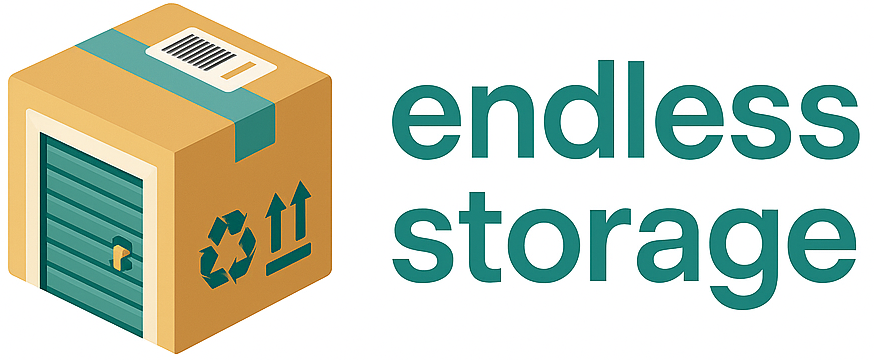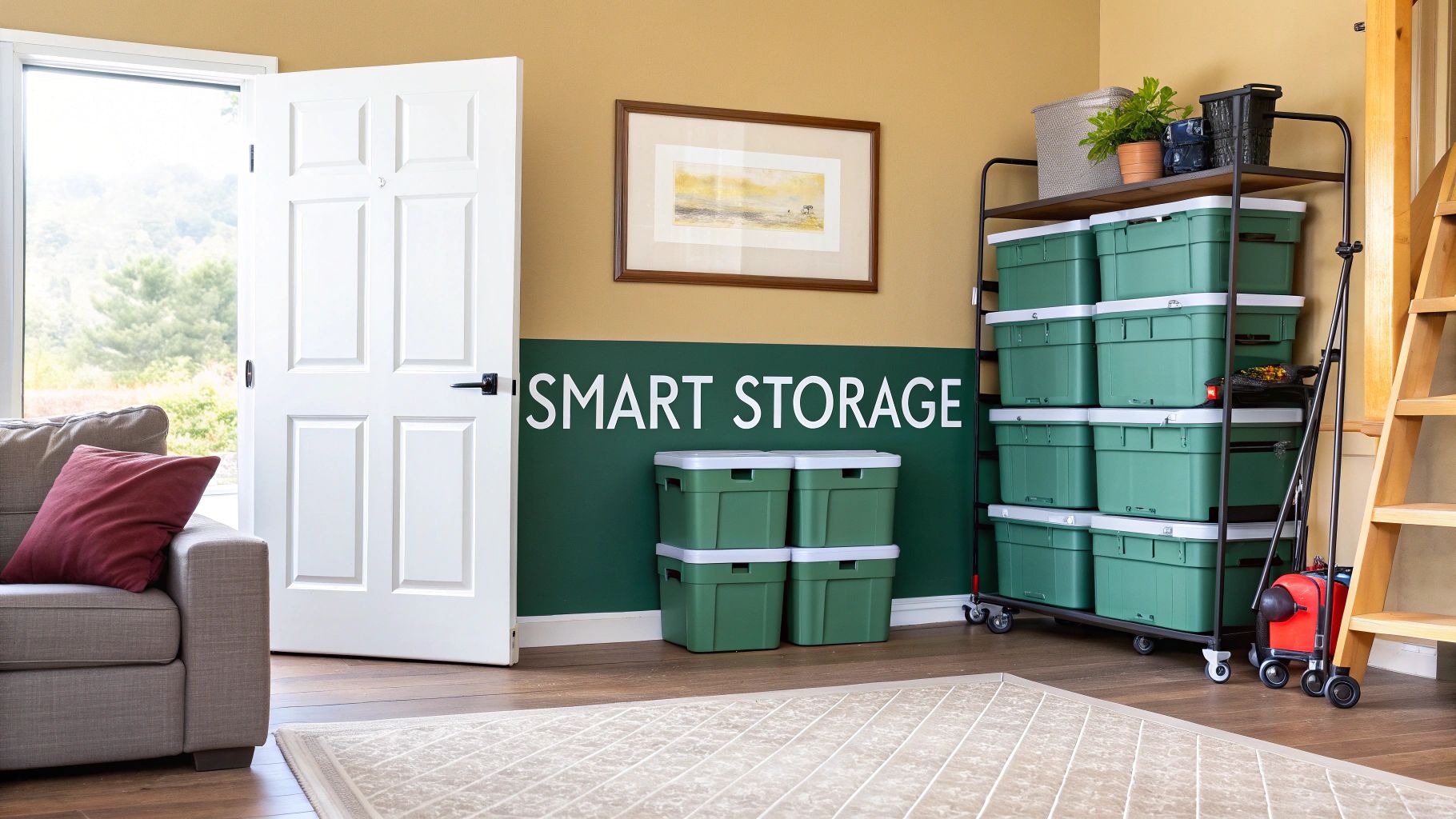Staring at overflowing closets and corners packed to the brim is a struggle every apartment dweller knows. The best storage units for apartment living aren't just a last resort for your extra stuff; they're a strategic extension of your home. This guide is all about helping you find that perfect solution to reclaim your space and finally breathe again.
Why Smart Storage Is a Game Changer for Apartment Life
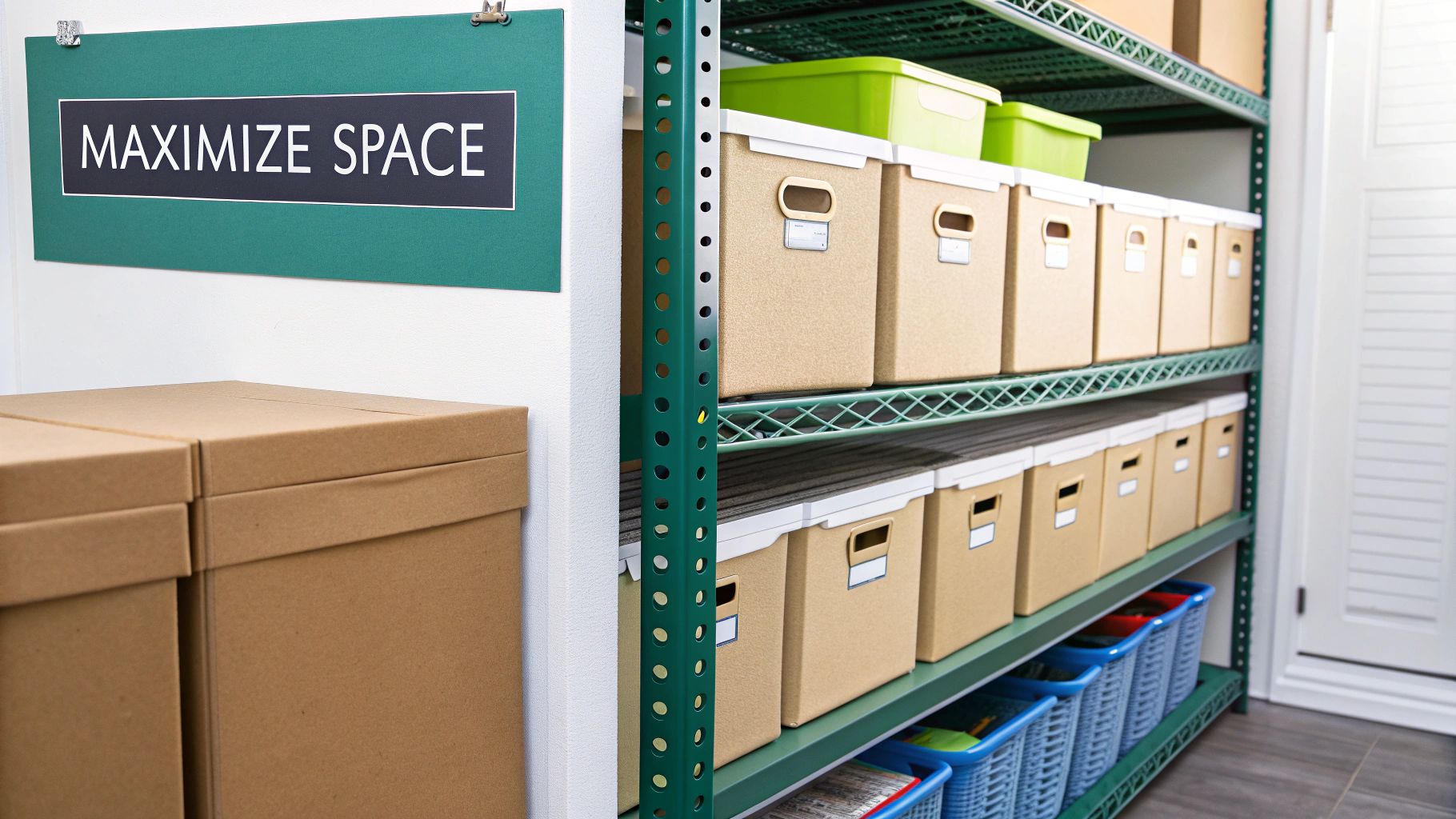
Living in a small apartment can feel like playing a constant game of Tetris with your belongings. Every single square foot is precious real estate, and just finding a home for everything can be a real headache. This is where a little outside help—an external storage unit—goes from being a nice-to-have to a total necessity.
Instead of thinking of it as a dusty old garage for things you’ve forgotten, picture it as a remote closet or an annex to your actual apartment. It’s a dedicated spot that gives your living space room to breathe, lifting that visual and mental weight of clutter right off your shoulders.
Reclaim Your Living Space
The biggest, most immediate win is getting all that valuable square footage back. By moving seasonal decor, bulky sports gear, or anything else you don't need day-to-day off-site, you can finally set up your apartment the way you've always wanted.
- Carve out a home office: That cluttered corner could become a productive workspace.
- Make room for your hobbies: Finally unroll that yoga mat, set up an easel, or find a spot for your guitar.
- Cut down on daily stress: It’s a proven fact that a tidy, organized home leads to lower stress and better mental clarity.
This isn’t just about stashing your things; it's about actively improving your quality of life. And it seems like everyone is catching on. The global self-storage market is expected to jump from USD 63.98 billion in 2025 to a massive USD 107.36 billion by 2034, mostly because so many of us are living in smaller, urban spaces.
By using a storage unit strategically, you're not just decluttering. You're making an investment in a more organized, flexible, and enjoyable life at home. It’s about making your apartment work for you, not the other way around.
This idea of optimizing your home goes way beyond just storage. To see how technology is reshaping modern living spaces, check out our guide to smart apartment technology, which covers all sorts of connected features that make life easier.
Decoding Your Apartment Storage Options
When you hear "storage unit," you probably picture a long hallway lined with roll-up metal doors. That classic image is still around, but the world of storage for apartment dwellers has grown way beyond that. Today, you’ve got a few different options, each built for a different lifestyle, budget, and need for convenience.
Think of it like getting around town. You could own a car, call a rideshare, or have a package delivered. They all get something from point A to point B, but the cost, effort, and control you have are completely different.
Traditional Self-Storage: Your Remote Closet
This is the one you know. You rent a private, secure space—anything from a small locker to a unit the size of a garage—at a dedicated facility. You’re in charge of moving everything in and out. This hands-on approach gives you total control and is often the most budget-friendly way to store bigger things like furniture or the contents of an entire room.
It’s basically your own remote closet. You have the key, and you can access your stuff whenever you want during the facility’s open hours. It’s perfect if you want direct access to your belongings. Thanks to the industry adding a massive 278.8 million square feet of new space across the U.S. between 2019 and 2023, finding a facility near your apartment is easier than ever.
Full-Service Valet Storage: Your Personal Concierge
Now, what if someone else did all the work for you? That’s valet storage in a nutshell. A company picks up your items, transports them to a secure warehouse, and brings them back whenever you ask—often with just a few taps in an app. It's the ultimate set-it-and-forget-it solution.
This is a game-changer for busy city dwellers who value their time more than anything. While it costs more than traditional storage, you can say goodbye to renting a truck or losing a weekend to hauling boxes. You trade direct, immediate access for maximum convenience.
The real difference comes down to access versus effort. With valet storage, you’re paying for a service that completely handles the logistics, freeing up your time and energy for other things.
This chart gives you a quick visual on the common unit sizes you’ll come across.
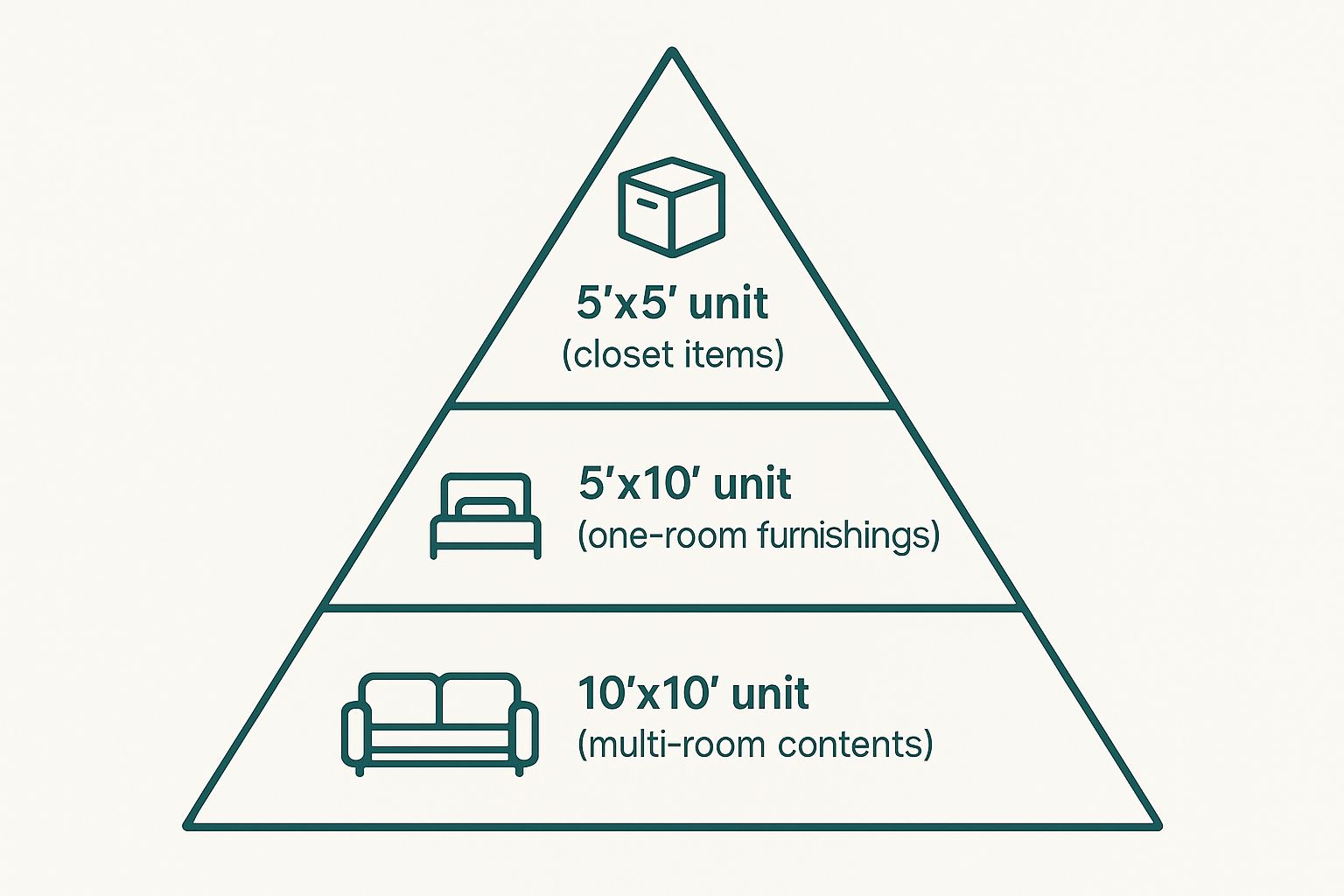
As you can see, even a small 5'x5' unit is great for closet overflow, while a 10'x10' can easily handle the basics from a one-bedroom apartment.
By-The-Box Storage: Mailing Items to Your Future Self
Sometimes you don't need to store a couch. What if you just need to get a few boxes of seasonal clothes, old textbooks, or sentimental keepsakes out of the way? That’s where by-the-box storage really shines. It’s the most targeted and often the most affordable option for smaller storage needs.
- How it works: The company sends you sturdy, empty boxes. You pack them up, and then they're picked up and stored individually in a secure warehouse.
- Best for: Students between semesters, minimalists decluttering, or anyone who just needs to clear out a few specific things without renting a whole unit.
- Key benefit: You only pay for the exact space you use—one box at a time.
Think of it like mailing things to your future self. It's the perfect solution for items you know you'll need down the road but don't want taking up precious closet space right now. For more ways to reclaim your space, check out our favorite small apartment storage hacks.
Apartment Storage Options at a Glance
Feeling a little overwhelmed by the choices? Don't be. Most people find that one of these options fits their needs perfectly. This quick table breaks down the key differences to help you see which one might be the best fit for you.
Ultimately, the right choice depends entirely on what you're storing, how often you'll need it, and how much heavy lifting you're willing to do yourself. Whether you need a remote closet, a personal concierge, or just a way to mail a few boxes to your future self, there’s a solution out there.
Finding the Perfect Fit Without Wasting Space
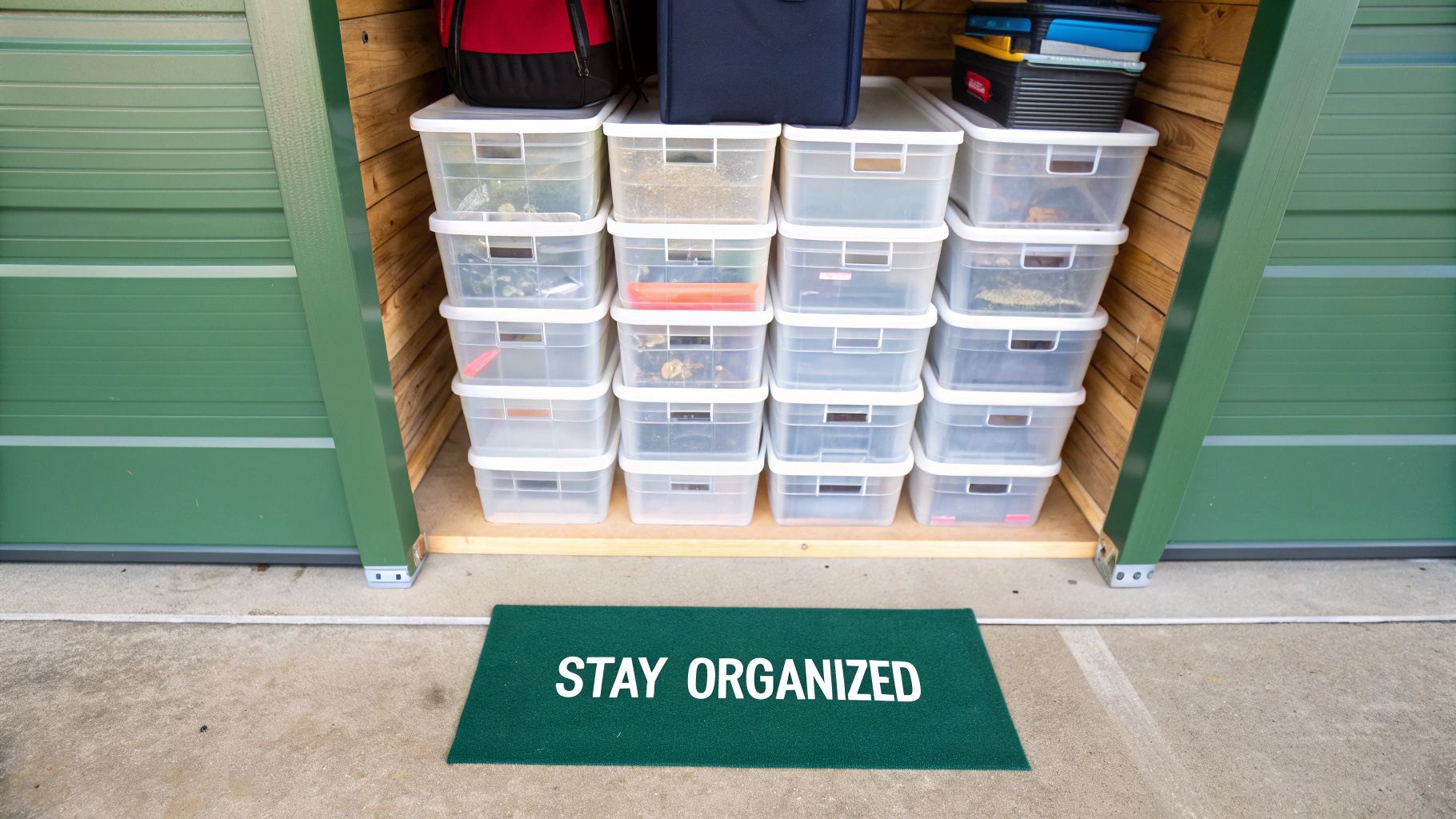
Picking the right storage unit size can feel like a high-stakes guessing game. If you go too small, you're left playing a frustrating game of real-life Tetris. But if you go too big, you’re literally paying for empty air every single month.
The trick is to stop thinking in abstract feet and inches and start translating those dimensions into something you know: your apartment.
Think of a 5x5 unit as your extra "seasonal closet." This 25-square-foot space is perfect for swapping out your wardrobe, stashing holiday decorations, or storing a few small pieces like a nightstand or a floor lamp. It’s the ideal way to reclaim precious closet space at home.
A 5x10 unit is more like a "studio apartment annex." With 50 square feet to work with, it can typically hold the contents of a small studio or a single bedroom. We’re talking a queen-size bed, a dresser, a TV, and several boxes—making it a go-to for apartment dwellers between leases.
From Guesswork to a Smart Estimate
To really nail down the right size, you need to do a quick inventory of what you plan to store. This doesn't have to be complicated; just grab a notepad or use a simple app on your phone.
Walk through your apartment and list every major item destined for the unit. Be specific—don't just write "boxes," but give a rough estimate of how many you'll have. This simple step turns a vague idea into a concrete list you can actually work with.
The goal isn't just to cram everything in, but to fit it in smartly. A well-organized unit lets you get to your stuff later, saving you the headache of digging through a mountain of boxes just to find one specific thing.
Once you have your list, you can plug it into an online storage calculator or simply visualize the items grouped together. This mental exercise helps you see if your belongings fit the "seasonal closet" or "studio annex" model, pointing you toward the most cost-effective storage units for apartment living. For more tips on making the most of your space at home, check out our other helpful storage ideas for apartments.
Maximizing Every Square Inch
Once you’ve chosen your unit, the real work begins: using the space wisely. A lot of renters forget about one of the most valuable dimensions in their unit: vertical space.
- Go Vertical: Always stack sturdy, similar-sized boxes to use the full height of the unit. Just remember to put heavier boxes on the bottom and lighter ones on top to prevent crushing.
- Create an Aisle: Even in a small unit, try to leave a narrow walkway down the middle. This allows you to access items in the back without having to unload everything first.
- Disassemble Furniture: Taking apart bed frames, tables, and shelving is a game-changer. It dramatically reduces their footprint and makes them much easier and safer to store.
By thinking strategically, you can make sure you’re only paying for the space you truly need and can get to your belongings without a major hassle.
Must-Have Features in a Storage Facility
Choosing the right storage facility is about a whole lot more than just finding a cheap, empty box to stick your stuff in. The features of the facility itself are what separate a secure second home for your belongings from a really risky gamble. Getting clear on the right amenities is key to protecting your investment—and your peace of mind.
Think of it like choosing a bank. You wouldn't just pick one because it's close by; you’d look at its security, customer service, and how it protects your assets. The exact same logic applies here, especially when you need reliable storage units for apartment living where every square foot counts.
Security Should Be Your Top Priority
Let’s be clear: robust security is the absolute non-negotiable. Your belongings are valuable, and the facility should treat them that way. Without solid security measures, you're pretty much just hoping for the best.
Here’s a quick checklist of what to look for:
- 24/7 Video Surveillance: Cameras should cover every angle—all entry points, hallways, and driveways. This isn't just about scaring people off; it provides crucial evidence if an incident ever occurs.
- Gated Access: The property needs to be fully fenced with a secure, electronic gate that requires a personal code to get in and out. No exceptions.
- Good Lighting: Well-lit hallways and outdoor areas are essential. Dark corners are an invitation for trouble and can make you feel unsafe, especially if you need to pop by after dark.
- On-Site Management: A manager who lives on the property or is present during business hours adds a huge layer of security and accountability.
The Critical Role of Climate Control
So many people underestimate the importance of climate control, but if you're an apartment dweller storing anything sensitive, it’s a must-have. A standard unit is basically a garage—it gets brutally hot in the summer and freezing cold in the winter. Those wild temperature swings can completely ruin your most prized possessions.
Climate-controlled units maintain a steady temperature and humidity level, typically somewhere between 55 and 80 degrees Fahrenheit. This stable environment is your best defense against mold, mildew, rust, and warping.
You absolutely need a climate-controlled unit if you're storing things like:
- Electronics: Laptops, TVs, and stereo equipment don't do well with extreme temps.
- Wooden Furniture: Think tables, chairs, and dressers that can crack or warp.
- Artwork and Photos: High humidity is the enemy of irreplaceable memories.
- Important Documents: Paper can degrade and become brittle over time.
Access and Excellent Service Matter
Finally, a great facility should work with your schedule, not against it. Look for convenient access hours that fit your life, including weekends or even 24-hour access if you might need it. Just as important is responsive and friendly customer service—it’s a major sign of a well-run operation. Our guide to choosing the right storage unit facilities dives deeper into what sets the best locations apart.
The demand for these kinds of features is only growing as city living gets more compact. The global self-storage industry is booming, with the United States leading the pack with approximately 69,400 facilities as of 2025, a number driven by our ever-growing need for extra space. This trend really underscores how essential these features have become. You can discover more insights about these industry statistics on StorTrack.com.
Navigating The Real Costs Of Renting A Storage Unit
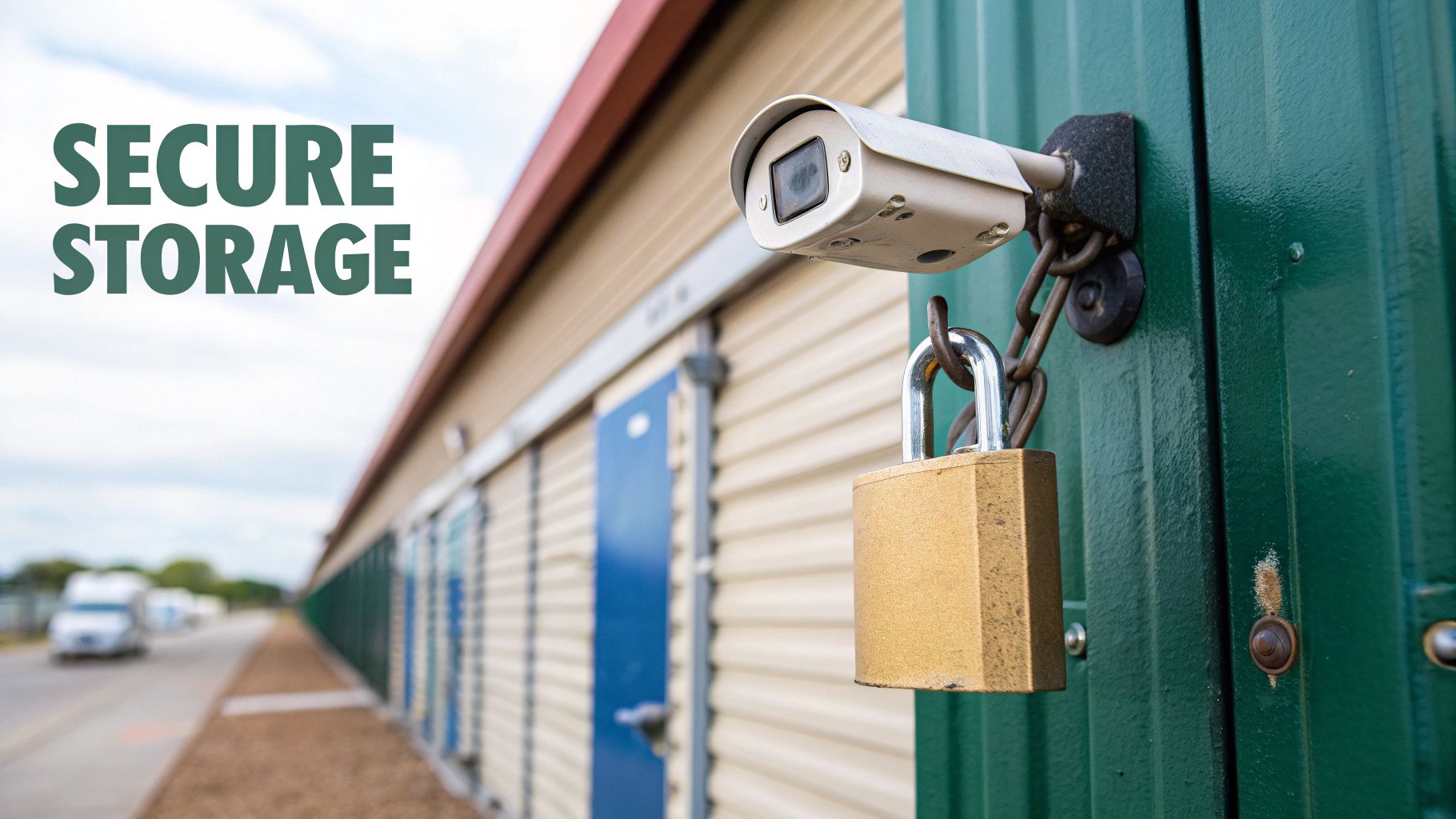
That flashy banner with the low monthly price? Think of it as the starting bid, not the final number. The real cost of renting a storage unit is almost always more complex, with a few key variables pushing the total on your monthly bill higher. Understanding what goes into that final price is the first step to setting a realistic budget and avoiding any nasty surprises.
The core of your rent is built on three main pillars: size, location, and features. It’s pretty straightforward—a small 5x5 unit is going to be cheaper than a sprawling 10x10 space. Likewise, a facility in a dense city center will run you more than one out in the suburbs. And if you need a climate-controlled unit to protect your stuff from heat and humidity, expect to pay a premium for it.
Uncovering The Hidden Fees
Beyond the base rent, a few extra charges can catch you off guard. They're often tucked away in the fine print of the rental agreement but can seriously inflate your monthly total. Knowing what to look for is crucial, especially when you're trying to find the right storage units for apartment living.
Here are the usual suspects to watch out for:
- Administrative Fees: This is a one-time charge, usually between $10 and $25, just for setting up your account and getting the paperwork sorted.
- Mandatory Insurance: Most places won’t let you store without insurance. You might be able to use your homeowner's or renter's policy, but many facilities will push you to buy theirs, adding another $10 to $30 to your bill each month.
- Locks: You have to bring your own lock. If you forget, you’ll have to buy one from the front desk, and they’re almost always marked up.
Always, always ask for a complete cost breakdown before you sign anything. Getting clarity on every single line item, from rent to potential late fees, is how you make a smart financial choice.
Budgeting For The True Total
To give you a better idea of how it all shakes out, let's walk through what a typical monthly bill might look like. These numbers can vary a lot, but this example shows how quickly things add up.
Here’s a sample breakdown of the potential monthly costs you might see when renting a storage unit. This should help you budget for more than just the advertised base rent.
Sample Monthly Cost Breakdown for a 5x10 Unit
As you can see, the add-ons can make a real difference.
And remember, those initial move-in specials are designed to get you in the door. It's vital to find out what the rent jumps to after the promotional period ends. For a deeper dive into keeping these expenses in check, check out our guide on finding affordable storage solutions. By planning for all the potential costs upfront, you can make sure your storage unit stays a helpful resource, not a financial headache.
Organizing Your Unit Like a Pro
Getting one of the best storage units for apartment dwellers is only half the battle. The real victory comes when you organize it so well that it feels like a seamless, functional extension of your home. A little planning up front saves you a ton of time and frustration every time you visit.
Think about it like organizing your kitchen pantry. You wouldn't just toss groceries in there and hope for the best, right? You group cans with cans, put the stuff you use daily right at the front, and make sure you can find the cinnamon without excavating a mountain of flour. That's the exact same logic we're applying here.
Create Your Master Plan
Before you even think about moving a single box into the unit, you need a game plan. The core principles of good organization are pretty universal, and you can borrow ideas from other parts of your home. In fact, learning how to organize pantry shelves like a pro can completely change how you approach your storage unit.
Start by sketching out a simple diagram of the unit's layout or creating a master inventory list on your phone. This gives you a bird's-eye view and stops you from forgetting where you put that one specific thing. From there, create "zones" for different categories—think "kitchen overflow," "seasonal clothes," or "important documents."
The single most important part of your layout is a clear walkway. Even in a tiny 5x5 unit, leaving a path down the middle means you can grab things from the back without having to unpack the entire space.
Smart Packing and Stacking Strategies
The packing materials you choose can make or break your organization. Using matching, clear plastic bins is an absolute game-changer. They stack neatly and securely, keep dust and moisture out, and—best of all—let you see what's inside at a glance. No more opening ten identical cardboard boxes.
Stick to these simple rules for a perfectly organized unit:
- Label Everything: Seriously, everything. Use big, bold labels on the top and at least one side of every single box. "Winter Sweaters & Scarves" is way more helpful than a mysterious "Clothes" label.
- Prioritize Access: Put the items you’ll need most often right at the front. Think seasonal decorations, camping gear, or specific paperwork. Easy in, easy out.
- Heavy to Light: This one’s crucial. Always stack your heaviest boxes on the bottom to create a sturdy foundation. This prevents lighter, more delicate items from getting crushed under the weight.
Getting your organization right does more than just save space—it protects your belongings and turns your storage unit into a genuinely useful tool. For more deep-dive strategies on taming clutter, check out our guide to apartment organization ideas.
Even after you’ve weighed the options, a few questions might still be bouncing around in your head. That's completely normal. Choosing a storage solution when you live in an apartment is a big decision, and getting clear answers to those last few concerns can make all the difference.
Let’s tackle some of the most common questions we hear from apartment dwellers like you.
What Can I Legally Store in a Unit?
This is a big one, and for good reason. For the most part, you can store typical household items—think furniture, extra clothes, books, and electronics. But for safety and legal reasons, some things are strictly off-limits.
Every facility will have a list of prohibited items, but you can almost always count on these being on it:
- Perishable food: Anything that can spoil or attract pests is a definite no-go.
- Hazardous materials: This includes things like gasoline, propane tanks, paint, fireworks, or anything flammable or explosive.
- Living things: No plants, no pets.
- Illegal or stolen goods: This one’s a given.
Always, always check your rental agreement for the full list. Breaking these rules isn't just a slap on the wrist; it can get you kicked out of your unit and lead to some serious trouble.
Do I Really Need Insurance?
The short answer? Yes. While good storage facilities have solid security, their own insurance doesn't cover what’s inside your unit. If something unexpected happens—like a fire or a burst pipe—you'll want your own coverage. In fact, most places require it.
Think of it as a safety net. You hope you never have to use it, but for a small monthly fee, you get real peace of mind knowing your valuables are protected if the worst happens.
Before you buy a policy from the storage company, check with your own insurance agent. You can often add storage coverage to an existing renter's or homeowner's policy, which is usually the more affordable route.
How Long Can I Rent a Unit?
Flexibility is key for apartment renters, and storage companies know this. The vast majority operate on simple, month-to-month leases.
This is perfect when you aren't sure what the next year holds. You’re not locked into a long-term contract, so you can store your things for just a month or for several years—whatever works for you.
Ready to reclaim your space without the hassle of a traditional storage unit? Endless Storage offers by-the-box solutions starting at just $7.99 per box per month. We send you the boxes, pick them up, and bring them back whenever you need them. Find your perfect, clutter-free solution.
Frequently Asked Questions
Unveiling the Secrets to Effortless Storage
Endless Storage is available nationwide. You pick a plan, tell us where to pickup, and we'll send a UPS van to collect, whichever state you're in.
Your shipping label will be sent to your email within a few minutes, if not instantaneously. It can also be accessed through your customer profile.
Your box will be shipped to one of our climate controlled self storage facilities in our closest self storage facility. Our manager will accept your package, notify you that your box has been received, and securely stored. Only our managers will have access to Endless Storage boxes.
Email us at admin@endless-storage.com click to live chat with us, or send us a message below.
Never! We're committed to transparent pricing with no surprises. You'll lock in your rate with no hidden fees and no long-term contracts.
Fast access guaranteed! Your boxes will arrive at your doorstep within 48 hours of requesting them back. Need to check on delivery? We provide tracking information for complete peace of mind.
Totally flexible! Store month-to-month with no long-term commitment and cancel anytime.
Everything's online! Use your account dashboard to:
• Set up automatic monthly payments
• Request box returns
• Update your address
• Order additional boxes
• Track shipments
Your boxes are insured up to $100 each. Our customer service team will help you file any necessary claims and resolve issues quickly.
Don't worry – we'll email you right away if there's a payment issue. Your items stay safe, though you may have temporary service interruption or late fees until payment is resolved.
When you request our free storage kits, you'll have 30 days to send in your boxes to activate your 3 months of free storage. Think of it like starting a gym membership – your activation window begins when you receive your kits, and your full free trial begins once you send in your first box. During your free months, you'll experience our complete storage service at no cost.
Your 30-day activation window begins when you receive your storage kits. We'll send you an email confirmation when your kits are delivered, marking the start of your activation period.
If you haven't sent any boxes for storage within your 30-day activation window, your free trial will expire and we'll begin charging the regular monthly rate of $9.99 per box. This helps ensure our storage kits go to customers who are ready to use our service.
A box costs $9.99 per month to store (plus sales tax). This price includes free shipping for standard boxes under 50 lbs. and smaller than 16"x16"x16"
Log into your Endless Storage account, locate the box you would like returned, and simply click Return My Box.
Yes, each box stored with us is insured for up to $100 throughout transit as well as the duration of storage within our facilities.
Your box will be at your doorstep within 48 hours of you requesting it back.
Store 10+ boxes? We'll pick them up for free! After your purchase, we'll contact you to schedule a convenient pickup time and arrange UPS collection.
We trust UPS with all shipments, and every box includes $100 insurance coverage. You'll receive tracking information to monitor your items' journey.
Yes! Visit any of our locations by appointment. Just bring a photo ID matching your customer profile.
For everyone's safety, we can't store hazardous materials, firearms, or perishables. All items must fit within our standard boxes.
It's easy! Order your storage kit online, and we'll ship it to you within 1-2 business days. Your shipping labels will be emailed instantly and available in your account.
We're here to help! Email us at admin@endless-storage.com, use our live chat, or send us a message through your account.
To cancel your storage service with Endless Storage, please email your cancellation request to admin@endless-storage.com. Our team will process your request within 2 business days and confirm your cancellation via email.
We understand packing takes time. However, to maintain your free trial benefits, you'll need to send at least one box within the 30-day activation window. If you need more time, you can always start with one box to activate your trial and send the rest later. You can always reach out to admin@endless-storage.com if you have any issues or concerns.
When you request our free storage kits, you're starting a 30-day window to begin using our storage service.
To avoid any charges, simply send at least one box for storage within 30 days to activate your 3-month free trial. If you decide not to use our service and don't send any boxes within the 30-day window, a one-time $50 fee will apply to cover the costs of materials and shipping. This helps ensure our storage kits go to customers who are ready to use our service.
Think of it like reserving a hotel room – we're setting aside space and sending specialized packing materials for your use. The fee only applies if you request materials but don't begin storage, similar to a hotel's no-show charge.
